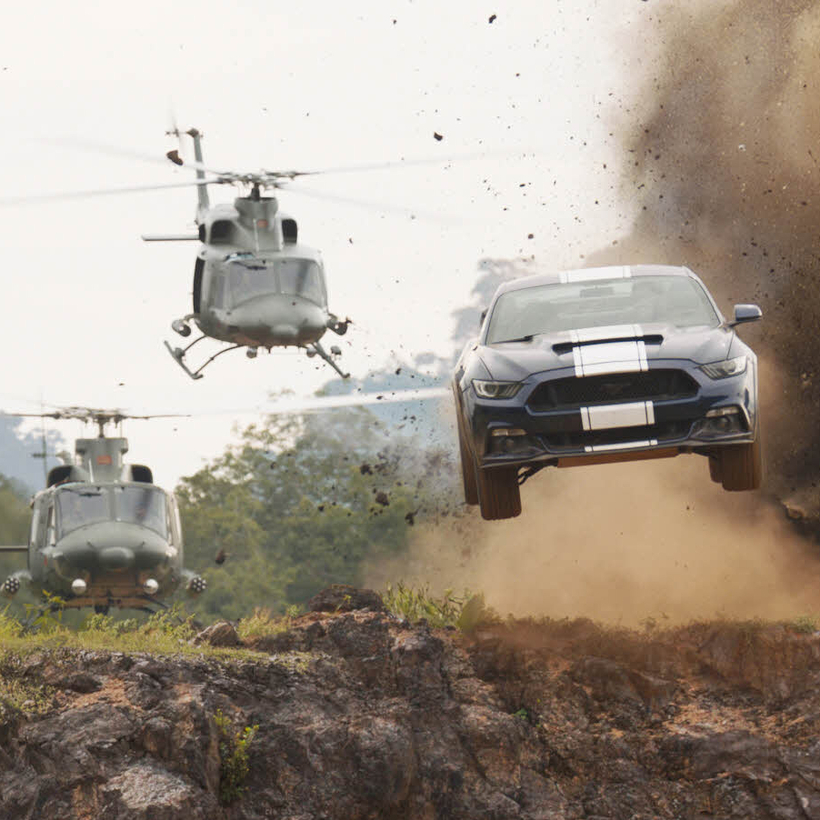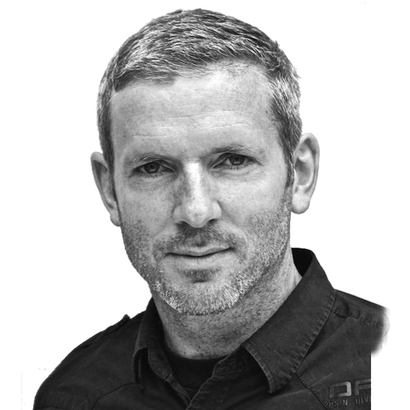A car drives down the street. Another car follows. It’s the oldest cinematic trick in the book, almost as old as the medium itself (Buster Keaton was caught up in multi-vehicular mayhem in 1924 in Sherlock Jr), and has produced some of the most definitive moments in movie history — Steve McQueen tearing through San Francisco in Bullitt, Gene Hackman racing through New York in The French Connection and Dennis Weaver playing chicken with a truck in Duel.
Yet recently the car chase has become the star of its own franchise. The Fast & Furious movies are a nine-episode $6 billion box office success story built around the basic concept of one car chasing another, but expanded and expanded until it’s 17 cars chasing a Russian nuclear submarine. Other wannabe car chase franchises have appeared and fizzled away while the F&F films have remained the brand leader for 20 years, untouchable in their ability to deliver the audience-pleasing essence of crash, bang, wallop.
Much of that is thanks to the 61-year-old Hollywood director Spiro Razatos, who has been the stunt co-ordinator and second-unit director on every F&F movie since the fifth (regarded by F&F cognoscenti as “the one where the franchise really came together”). Razatos, who began his career doing comedy pratfalls on The Goonies (he doubled for the movie’s villain, Joe Pantoliano), says that the allure of a good car chase is about “giving people a thrill ride, but making them feel, simultaneously, the impact of the story”. He says there’s no guarantee that every car chase is going to work on-screen, but following these rules is a good place to start.

1. Treat the Chase like Serious Drama
“When I first started working with [the F&F 9 director] Justin Lin on Fast 5 we were mapping out a chase sequence, and I said, ‘OK, I’m going to have the car turn right down this street and …’ And he interrupted and said, ‘Wait. Why is he turning right and not left?’ And I had never been asked that before. It was like an actor asking, ‘Why am I saying this line this way, or walking to the right and not the left?’ And it only hit me then. The chase should be just like drama. I have to account for everything we do, why we do it, and give it a good reason.”
2. Ditch the Tech Wizardry
Razatos is, to put it mildly, not a fan of CGI effects in car chases. “The first Fast movie was the best one because everything was done the old-fashioned way and real. People back then needed a break from the CGI effects that were in every movie. It was a pleasure for them to see that stunts were being done for real, and that we were finally bringing reality back to these chases. So when I go into production meetings now and everyone says, ‘Oh we can do that later with CGI,’ I fight hard to keep it real. And I fight — sometimes to my downfall because it’s become my reputation — because I believe it’s what the audience like.”
3. Stick to Your Guns
In F&F 9, during a climactic chase in Tbilisi, Georgia, Razatos added a scene where a lorry carrying a huge electromagnet passes by a white goods store and, due to the strength of the magnet, sucks all the washing machines and tumble dryers out through the store’s plate-glass windows. It’s a tension-breaking comedy highlight but initially Lin didn’t want it.
“I suggested it to Justin and he said, ‘Nah, they wouldn’t have a store like that there, and it wouldn’t look real.’ But in my heart I just thought, ‘The audience is going to like this.’ So I kept following Justin around with it. I’d bug him every time we had a meeting, and I’d ask him to let me show him storyboards of how the shots would work. And then finally, when we were scouting locations in Tbilisi, we walked by the front of a store that sold nothing but washers and dryers and Justin just smiled because he knew, deep down, that it meant a lot to me, and so he let me have it.”

4. Put the Audience in the Action
“I have shots in Fast & Furious 9 from inside a cafeteria looking out at the chase. For me that’s important and I do it in every movie. I always try to put the audience in a position where it feels like the chase is happening for them. I want them to go, ‘Yeah, I can imagine being at lunch, or in a Starbucks, and then suddenly this happens.”
5. Don’t Imitate
“I never look at other chases in other movies to copy them. They said to me, on the chase for [the 2008 assassination thriller] Vantage Point, ‘Make it look like Bourne.’ I said, ‘I will give you the feel of Bourne, but I am not going to literally copy Bourne.’ I’m better, instead, at creating on the fly. I like to go in prepared to get the shots that matter, but then also being able to create something else. That’s where a lot of my best stuff comes from.”
6. Don’t Mess with Physics
The first standout chase in F&F 9 is set in the fictional South American country of Montequinto, but was shot entirely in Thailand. It features a breakneck race through a live minefield, some crazy motorbike action and multiple car flips and midair smashes. It climaxes with a wonderfully silly bit of hokum (clearly done on computers) involving cars swinging through the air, flying over water and even driving vertically up along a collapsed rope bridge.
Razatos just hopes that you can tell the difference between the stunts and the silliness. “For me that’s hard because Thailand was nearly all practical stunts. All those explosions, all those cars flipping? It’s real. And we had to do it in the middle of monsoon season, being pummeled with rain every day. So, obviously, my personal concern is that if something at the end of the chase gets too unreal, will all the stuff leading up to it lose its effectiveness? And will audiences be wondering, ‘Well, was the rest of it not real either?’ I never want to lose the audience. But in the Fast movies 90 percent of what we do is real.”
7. Keep the Camera Low and Up Close to the Action
The chase sequence in Bullitt was made possible by a rig that kept the camera just six inches from the ground, thereby conveying an overexaggerated sense of speed. It’s a lesson that Razatos has internalized and applies to all stunts. “When I first got hired for the Fast movies it was because Justin had seen my demo reel and what he noticed was that nobody put the camera as low to the ground or as close to the action as I did. Everybody’s got their thing, and not everybody would want to go that low or that in-your-face. But that was mine.”

8. Cut to the Pedals
The “insert” shots during any car chase are the cutaways from the wide action footage into something much closer and more intimate. Sometimes it’s a facial reaction or the delivery of a line of dialogue. In the Fast franchise the archetypal insert is a rapid sequence of cuts to a hand on the gear stick, a foot on the accelerator pedal, and a twist of the steering wheel.
“Justin is very picky about how he uses those little inserts, and how he cuts to the gears and the pedals. Because these are all the little things that add to the viewer feeling that they’re the ones who are grabbing, shifting gears, accelerating and then hitting the breaks. It’s about making the audience feel that they’re in the chase with you, and the idea is to get their palms sweaty. You should have sweaty palms from watching it because you haven’t had a chance to take a breath. That’s the idea of a well-done chase.”
9. Be a Director
Razatos is a second-unit director, which essentially means that he’s the one filming the action. He spent F&F 9 in Thailand, Tbilisi, London and Los Angeles filming the movie’s pivotal chase scenes, while Lin was busy working with the talent (Vin Diesel, John Cena, Helen Mirren et al). The idea that a movie director is the one down on the street shouting “action” every time while cars smash into each other on cue is something of an illusion.
“Justin has certain shots that he needs me to get, for sure, but then he just lets me go and do what I do. When we shot the entire finale sequence I told him what the cars were going to do, and where they were going to crash, and he simply trusted me and let me go.”
10. Above All, Keep It Real
That finale sequence, but for a single stunt involving a flipped tandem juggernaut, was entirely real and includes an extraordinary shot where two giant pick-up trucks plough through a never-ending line of parked cars.
“When we’re running down that street and flipping those cars in the air, every single one of those is real, 100 percent. All those cars. I went through nearly 70 cars until we finally ran out. We had to go looking for cars that weren’t already trashed so we could put them back out onto the street in order to flip them again. The audience, of course, doesn’t know exactly that it’s real, but they feel it. They feel it and, I think, because it’s real, they walk away satisfied.”


